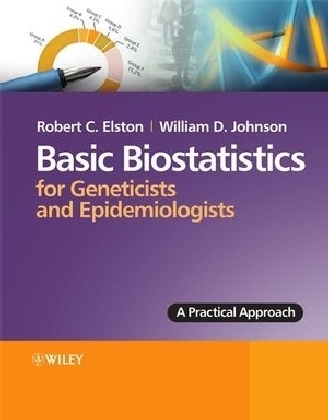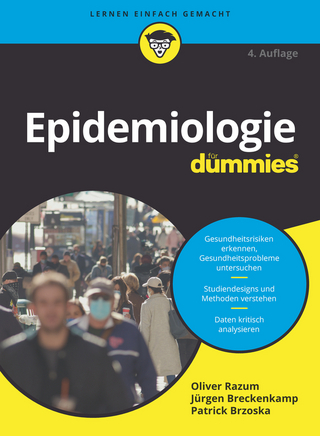
Basic Biostatistics for Geneticists and Epidemiologists
John Wiley & Sons Inc (Verlag)
978-0-470-02489-8 (ISBN)
Anyone who attempts to read genetics or epidemiology research literature needs to understand the essentials of biostatistics. This book, a revised new edition of the successful Essentials of Biostatistics has been written to provide such an understanding to those who have little or no statistical background and who need to keep abreast of new findings in this fast moving field. Unlike many other elementary books on biostatistics, the main focus of this book is to explain basic concepts needed to understand statistical procedures.
This Book:
Surveys basic statistical methods used in the genetics and epidemiology literature, including maximum likelihood and least squares.
Introduces methods, such as permutation testing and bootstrapping, that are becoming more widely used in both genetic and epidemiological research.
Is illustrated throughout with simple examples to clarify the statistical methodology.
Explains Bayes’ theorem pictorially.
Features exercises, with answers to alternate questions, enabling use as a course text.
Written at an elementary mathematical level so that readers with high school mathematics will find the content accessible. Graduate students studying genetic epidemiology, researchers and practitioners from genetics, epidemiology, biology, medical research and statistics will find this an invaluable introduction to statistics.
Robert C Elston, Professor Genetic and Molecular Epidemiology Track, Department of Epidemiology and Biostatistics, School of Medicine Case Western Reserve University, USA. An internationally prominent genetic epidemiologist with many years teaching experience. William D Johnson, Medical Center, University of Mississippi, USA. An experienced human geneticist.
Preface ix
1 Introduction: The Role and Relevance of Statistics, Genetics and Epidemiology In Medicine 3
Why Biostatistics? 3
What Exactly is (are) Statistics? 5
Reasons for Understanding Statistics 6
What Exactly is Genetics? 8
What Exactly is Epidemiology? 10
How Can a Statistician Help Geneticists and Epidemiologists? 11
Disease Prevention versus Disease Therapy 12
A Few Examples: Genetics, Epidemiology and Statistical Inference 12
Summary 14
References 15
2 Populations, Samples, and Study Design 19
The Study of Cause and Effect 19
Populations, Target Populations and Study Units 21
Probability Samples and Randomization 23
Observational Studies 25
Family Studies 27
Experimental Studies 28
Quasi-Experimental Studies 36
Summary 37
Further Reading 38
Problems 38
3 Descriptive Statistics 45
Why Do We Need Descriptive Statistics? 45
Scales of Measurement 46
Tables 47
Graphs 49
Proportions and Rates 55
Relative Measures of Disease Frequency 58
Sensitivity, Specificity and Predictive Values 61
Measures of Central Tendency 62
Measures of Spread or Variability 64
Measures of Shape 67
Summary 68
Further Reading 70
Problems 70
4 The Laws of Probability 79
Definition of Probability 79
The Probability of Either of Two Events: A or B 82
The Joint Probability of Two Events: A and B 83
Examples of Independence, Nonindependence and Genetic Counseling 86
Bayes’ Theorem 89
Likelihood Ratio 97
Summary 98
Further Reading 99
Problems 99
5 Random Variables and Distributions 107
Variability and Random Variables 107
Binomial Distribution 109
A Note about Symbols 112
Poisson Distribution 113
Uniform Distribution 114
Normal Distribution 116
Cumulative Distribution Functions 119
The Standard Normal (Gaussian) Distribution 120
Summary 122
Further Reading 123
Problems 123
6 Estimates and Confidence Limits 131
Estimates and Estimators 131
Notation for Population Parameters, Sample Estimates, and Sample Estimators 133
Properties of Estimators 134
Maximum Likelihood 135
Estimating Intervals 137
Distribution of the Sample Mean 138
Confidence Limits 140
Summary 146
Problems 148
7 Significance Tests and Tests of Hypotheses 155
Principle of Significance Testing 155
Principle of Hypothesis Testing 156
Testing a Population Mean 157
One-Sided versus Two-Sided Tests 160
Testing a Proportion 161
Testing the Equality of Two Variances 165
Testing the Equality of Two Means 167
Testing the Equality of Two Medians 169
Validity and Power 172
Summary 176
Further Reading 178
Problems 178
8 Likelihood Ratios, Bayesian Methods and Multiple Hypotheses 187
Likelihood Ratios 187
Bayesian Methods 190
Bayes’ Factors 192
Bayesian Estimates and Credible Intervals 194
The Multiple Testing Problem 195
Summary 198
Problems 199
9 The Many Uses of Chi-Square 203
The Chi-Square Distribution 203
Goodness-of-Fit Tests 206
Contingency Tables 209
Inference About the Variance 219
Combining p-Values 220
Likelihood Ratio Tests 221
Summary 223
Further Reading 225
Problems 225
10 Correlation and Regression 233
Simple Linear Regression 233
The Straight-Line Relationship When There is Inherent Variability 240
Correlation 242
Spearman’s Rank Correlation 246
Multiple Regression 246
Multiple Correlation and Partial Correlation 250
Regression toward the Mean 251
Summary 253
Further Reading 254
Problems 255
11 Analysis of Variance and Linear Models 265
Multiple Treatment Groups 265
Completely Randomized Design with a Single Classification of Treatment Groups 267
Data with Multiple Classifications 269
Analysis of Covariance 281
Assumptions Associated with the Analysis of Variance 282
Summary 283
Further Reading 284
Problems 285
12 Some Specialized Techniques 293
Multivariate Analysis 293
Discriminant Analysis 295
Logistic Regression 296
Analysis of Survival Times 299
Estimating Survival Curves 301
Permutation Tests 304
Resampling Methods 309
Summary 312
Further Reading 313
Problems 313
13 Guides to a Critical Evaluation of Published Reports 321
The Research Hypothesis 321
Variables Studied 321
The Study Design 322
Sample Size 322
Completeness of the Data 323
Appropriate Descriptive Statistics 323
Appropriate Statistical Methods for Inferences 323
Logic of the Conclusions 324
Meta-analysis 324
Summary 326
Further Reading 327
Problems 328
Epilogue 329
Review Problems 331
Answers to Odd-Numbered Problems 345
Appendix 353
Index 365
| Erscheint lt. Verlag | 1.12.2008 |
|---|---|
| Verlagsort | New York |
| Sprache | englisch |
| Maße | 181 x 254 mm |
| Gewicht | 822 g |
| Themenwelt | Mathematik / Informatik ► Mathematik ► Wahrscheinlichkeit / Kombinatorik |
| Studium ► Querschnittsbereiche ► Epidemiologie / Med. Biometrie | |
| ISBN-10 | 0-470-02489-5 / 0470024895 |
| ISBN-13 | 978-0-470-02489-8 / 9780470024898 |
| Zustand | Neuware |
| Haben Sie eine Frage zum Produkt? |
aus dem Bereich


